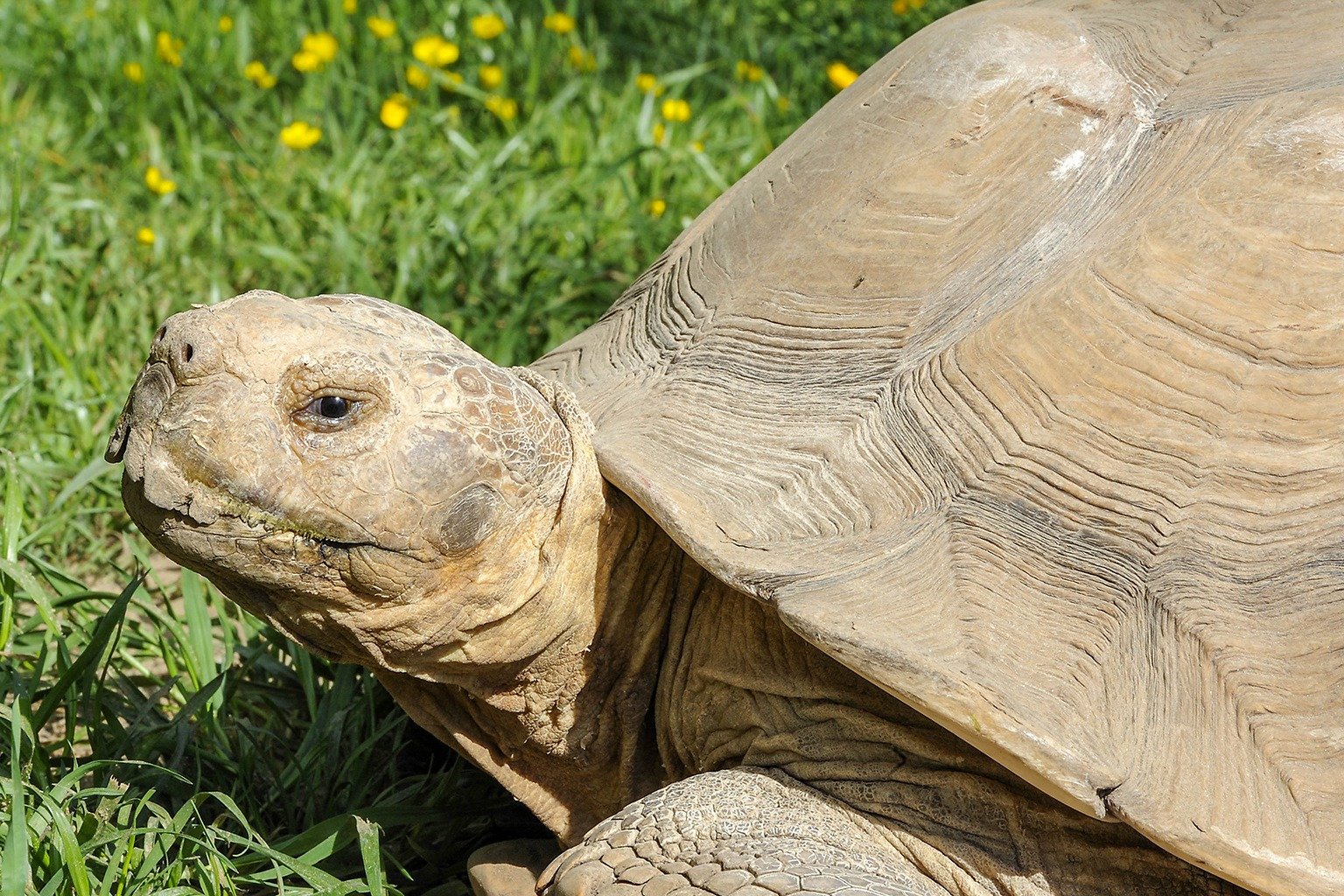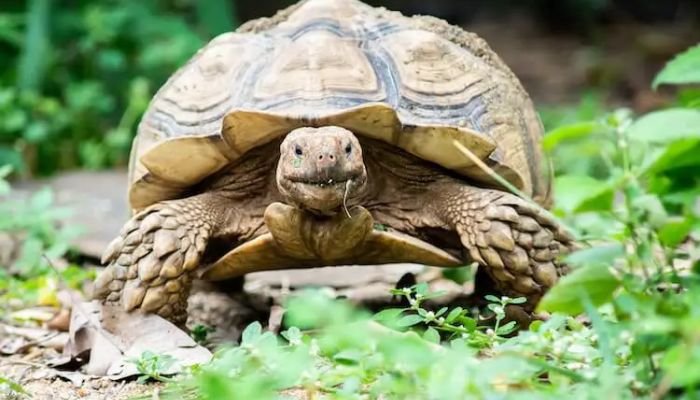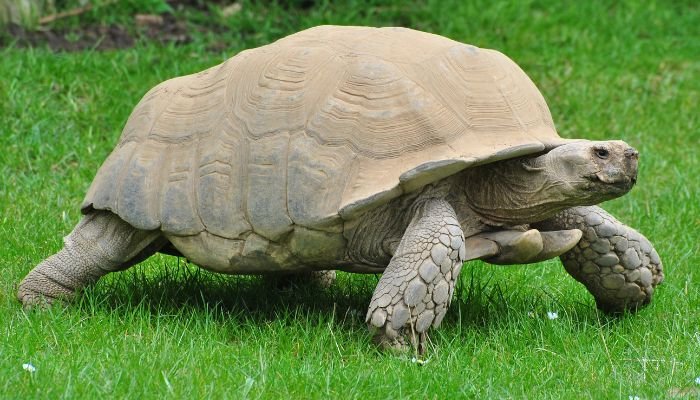
The Sulcata tortoise, also known as the African spurred tortoise, is an intriguing species that is adored by people all over the world who cherish unusual pets. Inhabitants of the Sahara Desert in northern Africa, these gentle giants are renowned for their enormous size and endearing dispositions. Here are Sulcata tortoise Guide on Food, Habitat, Size, Lifespan & Predators below-
Sulcata tortoise Stats in Table format
The stats are given below for Sulcata tortoise
| Reptiles List | Sulcata tortoise |
|---|---|
| Family | Testudinidae |
| Type | Tortoise |
| Size | Large |
| Length | Sulcata tortoise: Up to 24-30 inches (60-75 cm) |
| Color | Sulcata tortoise: Typically has a brown or yellowish coloration. |
| Weight | Sulcata tortoise: Adult Sulcata tortoises can weigh between 100 to 200 pounds or more.. |
| Lifespan | 70-100 years (or more) |
| Reproduction | Oviparous, lays eggs |
| Gestation Periods | The gestation period for a Sulcata tortoise is approximately 90-120 days. |
| Endangered Status | Vulnerable (IUCN Red List) |
| Features | Domed shell, large scaled limbs |
| Country & Areas | Sulcata tortoises are found in the countries of Africa, specifically in the Sahel region and the southern Sahara Desert. |
Sulcata tortoise Natural Habitat and Distribution
Senegal, Mauritania, Mali, Niger, Chad, Sudan, and Ethiopia are just few of the nations where you can find the Sulcata tortoise (Centrochelys sulcata), a tortoise endemic to the arid regions of sub-Saharan Africa. They live in the savannas and grasslands to the north and east of the Sahara. Tortoises of the Sulcata species have adapted successfully to the dry, hot climate of their native range.
Sulcata Tortoise Physical Features and Adaptations
Here are some information about Sulcata Turtle Physical Features and Adaptations
1. Body Structure
- Adult Sulcata tortoises can grow to an astonishing 24–30 inches in shell length and 100–200 pounds in weight, making them one of the largest tortoise species.
- Their plastron (lower shell) is flatter and allows for easier ground movement, while their dome-shaped carapace (upper shell) provides protection.
- Their robust limbs allow them to move easily across sandy terrain and dig efficiently in it.
2. Coloration and Patterns
Sulcata tortoises are able to blend in with their dry environments thanks to their tan or yellowish-brown shells. The shell’s elevated scutes (scales) and characteristic growth rings set it apart.
3. Defense Mechanisms
- Sulcata tortoises will hide behind their shells if they feel threatened. Their size and shell are sufficient deterrents for many would-be predators.
- They dig tunnels with their strong legs to protect themselves from the elements and predators.
Sulcata Tortoise Diet and Feeding Habits
Here are some information about Sulcata tortoise Diet and Feeding Habits
1. Diet Type
- Herbivorous, meaning they feed largely on plant matter, is the best way to describe Sulcata tortoises.
2. Preferred Food Sources
- Their primary food source in the wild is the grasses, weeds, leafy greens, and other flora typical of dry climates.
- A high-fiber, low-protein, and low-fat diet is recommended while they are in captivity. Grass hay, dark greens, cactus pads, and even the rare fruit like watermelon all make good choices.

3. Feeding Schedule
- Sulcata tortoises require daily feedings of grass hay once they reach adulthood. Fresh vegetables and greens should be provided multiple times weekly.
- Young tortoises should have access to food constantly throughout the day, as they need to be fed more often.
Sulcata tortoise Housing and Enclosure Requirements
Here are some information about Sulcata tortoise Housing and Enclosure Requirements
1. Terrarium Size and Setup
Outdoor enclosures, if weather permits, provide the perfect living conditions for Sulcata tortoises.
A hatchling’s enclosure needs to be at least 3 feet by 3 feet if it’s going to be kept indoors. You’ll need to make more room for them as they get older. The minimum recommended size for an adult enclosure is 8 feet by 8 feet.
2. Substrate Options
The substrate in the cage should be as close as possible to the conditions found in the animals’ native environment. The ability to dig and burrow is made possible by this.
3. Temperature and Lighting
The ideal temperature for a basking Sulcata tortoise is between 95 and 100 degrees Fahrenheit (35 and 38 degrees Celsius). The cage should be kept between 24 and 29 degrees Celsius (75 and 85 degrees Fahrenheit) during the day and night.
To aid with calcium metabolism and preserve shell and bone health, UVB lighting should be provided.
4. Humidity and Water Needs
- Their native dry habitat necessitates a rather low humidity level in the enclosure. The ideal relative humidity is between 30 and 50%.
- Maintain a constant supply of clean water for washing and drinking. The tortoise’s water dish should be shallow so it doesn’t topple over.
Sulcata tortoise Behaviour and Temperament
Here are some information about Sulcata tortoise Behaviour and Temperament
1. Activity Levels
- Sulcata tortoises are primarily diurnal, or active during the day and sleeping at night.
- Though generally sluggish, they show surprising spurts of activity when foraging or constructing their underground homes.
2. Social Behaviour
- Even though they aren’t naturally social, Sulcata tortoises may get along with one another in the wild and in captivity.
- However, when resources like food and shelter are scarce, interactions may become territorial or hostile.
3. Handling and Taming
- Sulcata tortoises are not accustomed to being handled, and too much interaction with a human can be stressful and even harmful to their health.
- Careful handling for brief periods of time is recommended if handling is required for health checks or enclosure maintenance.
Sulcata tortoise Breeding and Reproduction
Here are some information about Sulcata tortoise Breeding and Reproduction
1. Mating and Courtship Rituals
Male Sulcata tortoises may become more dominant and possessive around nesting time.
During courtship, the male will chase the female and attempt to mount her. If she is receptive, the female may put up some resistance during the mating process, but will eventually give in.
2. Incubation and Hatchlings
- After mating successfully, the female will dig a little nest in the ground and place her eggs there.
Depending on the circumstances, the incubation period might range anywhere from 90 to 120 days. - Upon emerging from their eggs, the newborns are usually left to fend for themselves.
Sulcata tortoise Common Health Issues and Veterinary Care
Sulcata tortoise Common Health Issues and Veterinary Care
1. Respiratory Infections
- Inadequate temperature, humidity, or ventilation in captive Sulcata tortoises can lead to respiratory illnesses.
- Whining, nasal discharge, and fatigue could be symptoms.
2. Parasites:
Sulcata tortoises are susceptible to both internal and external parasites, like worms and ticks. Keeping on top of parasite burdens requires routine fecal examinations and preventative treatments.
3. Metabolic Bone Disease
Captive tortoises often suffer from metabolic bone disease (MBD) because of inadequate nutrition and inadequate ultraviolet radiation.
Bone weakness, shell abnormalities, and other major health issues are all possible outcomes of MBD.

Importance of Regular Vet Check-ups
- Sulcata tortoises must have regular checkups with a veterinarian to ensure their health and well-being. A reptile vet who knows what they’re doing can:
- Perform in-depth checks to spot the earliest possible indicators of disease or other health problems.
- Help people avoid common health problems by advising them on how to eat, live, and care for themselves properly.
- Give the tortoise any shots or medication it may need to stay healthy.
Provide recommendations on how to keep captive environments healthy.
Conclusion:
In sum, Sulcata tortoises are remarkable animals because of their specialized traits and activities. In addition to thriving in dry climates, they have certain dietary, housing, and care needs that must be met. Reproduction is a natural part of their life cycle, however they should be handled as little as possible to prevent unnecessary stress. These stunning tortoises require routine veterinary care to ensure they continue to flourish and have long, healthy lives while kept as pets.
Facts
- Tortoises of the genus Sulcata have acute hearing and the ability to hide their heads, forelimbs, and tails inside their shells.
- In order to conserve water in their dry environment, they have thick, scaly skin.
- These tortoises can use their excellent sense of smell to discover food and mates.
- For healthy digestion, a Sulcata tortoise’s diet should mostly consist of high-fiber grasses, hay, and leafy greens.
- They need access to clean water at all times for hygiene purposes.
- Sometimes, albeit not as frequently as in other tortoise species, sulcata tortoises will make a “chirp” or other vocalization.
- Owning a Sulcata tortoise is a long-term commitment due to the animal’s great size and extended longevity.
- Metabolic bone disease is just one of several health problems that can develop from poor diet and care.
- Some African societies place significant cultural and symbolic value on these tortoises.
- When engaging with other tortoises, Sulcatas may engage in dominance posturing because to their distinct social tendencies.
- Providing captive animals with enrichment activities, such as the chance to investigate novel things or complete challenging tasks, can assist maintain their cognitive function.
- Because of their exceptional propensity for rapid weight gain, Sulcata tortoises must be carefully monitored to prevent them from becoming obese.
- They have strong jaws and sharp beaks that they can utilize as a defense strategy if they feel threatened.
- When Sulcata tortoises kept as pets are released into their natural habitats, they might spread to areas where they are not native.
- The health and growth of their shells depend on exposure to sunshine and UVB rays.
- Sulcata tortoises can swim well and cross rivers and other bodies of water with ease.
- They may share water sources with other species in the wild, including African elephants.
- Their sluggish growth rate allows their ages to be calculated using growth rings in their shells.
The traditional medical use of Sulcata tortoise shells threatens their numbers in some regions. - The power of their beaks allows them to shred and eat through tough foliage.
- Due to their specific environmental requirements, Sulcata tortoises can only be found in a tiny portion of Africa.
- They are a threatened species, hence there are efforts to preserve them in their natural habitat by a number of groups.
- Having a Sulcata tortoise as a pet is regulated and requires licenses in several countries.
- Their massive size and interesting traits make them appealing pets for serious reptile keepers, but novices should go elsewhere.
FAQs
Q: What is the family and Type of a Sulcata tortoise?
The Sulcata tortoise, or Centrochelys sulcata, is a species of tortoise in the family Testudinidae.
Q: What is the average size of a Sulcata tortoise?
A mature Sulcata tortoise can have a shell length of up to 30 inches (76 cm).
Q: How long can a Sulcata tortoise grow in size and length?
The sulcata tortoise can attain a massive size, with a shell length of 30 inches or more (76 cm).
Q: What colors do Sulcata tortoises come in?
The shells of Sulcata tortoises are brownish to yellowish brown, and their skin is a muted tint. Tortoises can have modest color variations between individuals.
Q: How big can a Sulcata tortoise get in weight?
As they age, Sulcata tortoises gain weight and can become rather hefty. The average adult weighs between 100 and 200 pounds (45 and 91 kilograms).
Q: How long do Sulcata tortoises live?
The average lifespan of a Sulcata tortoise in captivity is about 30 years. They have a potential lifespan of 70 years or more with TLC.
Q: How do Sulcata tortoises give birth?
The sulcata tortoise lays eggs, hence it is oviparous. The female tortoise will locate a good spot in the ground and dig a hole in which to lay her eggs. She then buries the nest to protect the eggs while they incubate.
Q: How long is the gestation period for a Sulcata tortoise?
The gestation period of a Sulcata tortoise is defined as the time that elapses between the laying of an egg and its fertilization. Depending on variables such as climate, the average duration is between four and nine weeks.
Q: Is the Sulcata tortoise endangered?
The Sulcata tortoise is not considered endangered as of my most recent check in September of 2021. However, they are in danger because to the destruction of their habitat and the illicit pet trade.
Q: What are the prey of Sulcata tortoises?
To answer your question, yes, Sulcata tortoises are herbivores. Grass, leaves, fruits, and other plants native to their environment make up the bulk of their food.
Q: Do Sulcata tortoises have any Predators?
The Sulcata tortoise is preyed upon by other animals in the wild. Large carnivorous mammals, birds of prey, and predatory reptiles are only some of the more prevalent predators.
Q: How Fast Does Sulcata Tortoises Move?
The Sulcata tortoise has a reputation for being slow. The average walking speed for these critters is only between 0.3 to 0.8 kilometers per hour (0.2 to 0.5 miles per hour).
Q. What is the Bite Force of Sulcata tortoise in PSI?
A Sulcata tortoise’s bite is weaker than that of most carnivores. Their bite strength is modest and can’t be quantified in pounds per square inch.
Q. Can we keep Sulcata tortoises as pets?
Some people do indeed keep Sulcata tortoises as pets. Potential owners, however, should be informed that they demand a substantial time investment due to their long lifespan and substantial size. Their health and happiness depend on receiving enough attention, having enough room, and living in an appropriate setting.
Q. Are Sulcata tortoises good for pest control?
To answer your question, no, Sulcata tortoises are not commonly utilized in pest management. They are herbivores, meaning they acquire their nutrition mostly from plants rather than insects.
Q. Do Sulcata tortoises require a UVB light source?
I hope you like reading on Sulcata tortoise FAQ Guide on Food, Habitat, Size, Lifespan and Predators.
